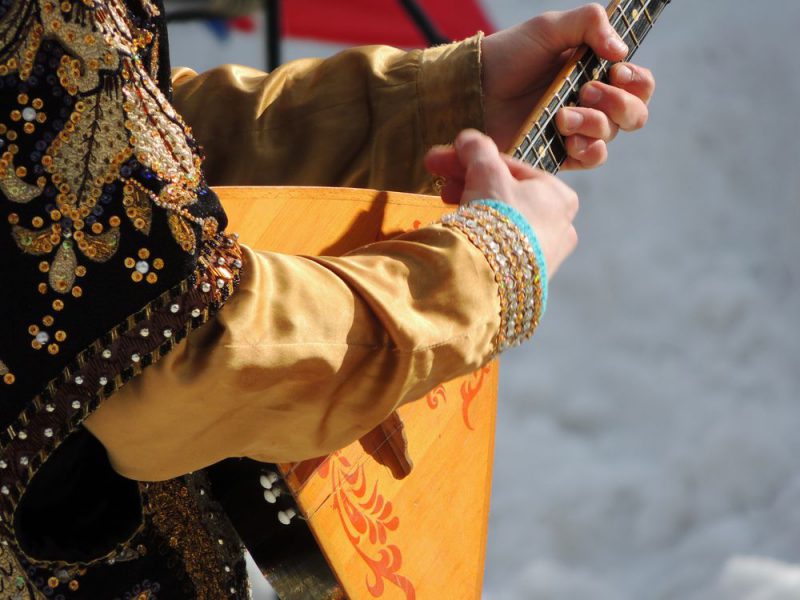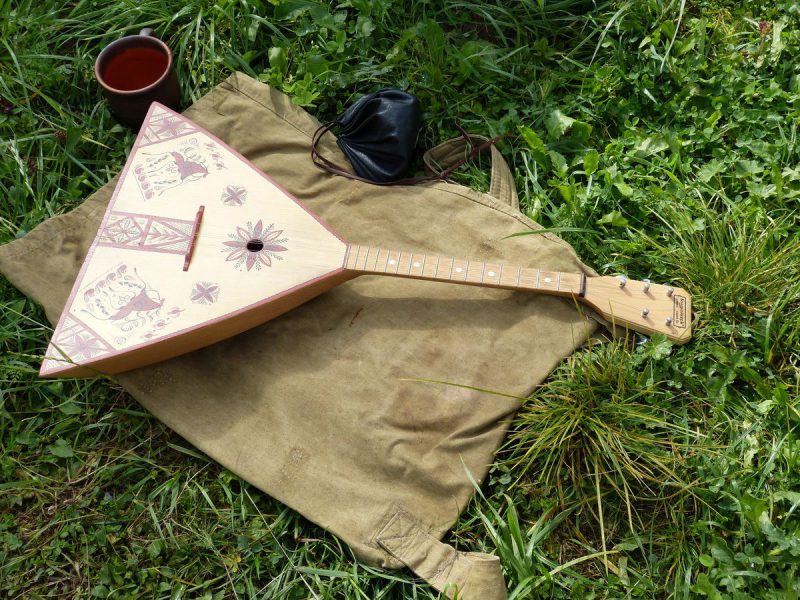Balalaika – The most famous Russian musical instrument
Balalaika is a Russian folk musical instrument. In case you never saw it, the balalaika resembles a guitar, only triangular in shape and with three strings.

Balalaika is the most famous Russian instrument. Along with the accordion and harp, balalaika has become one of the symbols of the musical creativity of the Russian people. Along with matryoshka, vodka, samovar and others, it is one of the unofficial symbols of Russia. Today we will tell you the history of the balalaika.
Origins of the balalaika
The history of balalaika is rooted in the depths of centuries… Despite the fact that there is a fairly large amount of documents and information, the researchers did not come to a unified version of its origins. Some people believe that the balalaika was invented in Russia, others think that it came from the folk instrument of the Kyrgyz-Kaisaks – dombra. There is also a version that the balalaika was invented during the Tatar rule, or at least borrowed from the Tatars.
It is believed that the balalaika has spread all over Russia since the end of the 17th century. According to Wikipedia, the first official records about the balalaika are dated 1688: the old document mentions two peasants who rode in a cart, played the balalaika and scolded the guards, for which they were arrested.
The balalaika spread among the peasants, as well as among buffoons (skomorokhs) who performed at fairs, entertained the people, and thus earned a living and a bottle of vodka. Often the repertoire of buffoons was against the existing powers: like true folk jesters, they made fun of politicians and the Orthodox church.
Hard times
It is not surprising that in 1648, a very pious tsar, the great prince of all Russia Alexei Mikhailovich issued a decree in which he ordered all the instruments (domra, balalaika, horns, harp, etc.) to be collected and burnt, and those who would not obey and would not give up their instruments should have been flogged and send to exile. In addition, everything that could fall under the definition of “demonic deeds and merrymaking” was forbidden. Playful songs, dances, and even a game of chess were classified as demonic. Most affected by this decree were musicians, vagrant artists and buffoons. All their activities suddenly became outside of the legal.

But time passed, the tsar died and the repression gradually stopped. The balalaika started sounding again throughout the country, but not for long. The time of popularity was again replaced by almost complete oblivion until the middle of the 19th century. Only rare peasants continued to play the balalaika.
Revival of balalaika
So the balalaika would have been totally lost if not for one day when a young nobleman Vasily Vasilievich Andreev, traveling on his estate, would not have heard the balalaika from his house-serf Antip. Vasily Vasilievich Andreev was struck by the peculiarity of the sound, and yet he considered himself an expert on Russian folk instruments. And he decided to make the balalaika the most popular instrument.
To begin with, he slowly learned to play, then he noticed that the instrument was fraught with enormous opportunities, and decided to improve the balalaika. Andreev went to St. Petersburg to the violin master Ivanov and asked him to think about how to improve the sound of the instrument. Ivanov, however, categorically refused to deal with the balalaika. Andreev then took out an old balalaika that he bought at the fair for thirty kopeks and masterfully performed one of the numerous Russian folk songs. Ivanov was very impressed and finally agreed. The work took a long time, but a new balalaika was eventually made.
However, Vasily Andreev conceived something more than just the creation of an improved balalaika. Having taken it from the people, he wanted to bring it back it to the people and to make it wide spread. Now every serving soldier was given a balalaika, and, leaving the army, took the instrument with him.
The days of glory
This way, the balalaika again spread throughout Russia and became one of the most popular instruments. Moreover, Andreev decided to create a family of balalaikas of different sizes on the model of a string quartet. For this, he gathered some of the best masters who, working together, made piccolo, descant, prima, sekunda, viola, bass, and contrabass balalaikas. From these instruments, the basis of the Great Russian Orchestra was created and then traveled to countless countries around the world glorifying the balalaika and Russian culture. It got so popular that in England, USA, and Germany, orchestras of Russian folk instruments were created as well.
In the beginning, Andreev played in the orchestra himself, then he conducted it. At the same time, he gave solo concerts, the so-called “balalaika evenings”. All this contributed to an unusual surge in the popularity of balalaika in Russia and beyond. Moreover, Vasily Vasilievich educated a huge number of students who also tried to support the popularization of balalaika. During this period, composers finally drew attention to the balalaika and, for the first time in its history, the balalaika sounded with an orchestra.
Balalaika today
Today the instrument is again going through hard times. There are only a few professional performers left. Balalaika is well forgotten in the modern villages. In general, folk music today is interesting to a very narrow circle of people who attend concerts or play folk instruments themselves.
There are very few famous balalaika players today who are trying to maintain the popularity of the great instrument and are engaged in teaching and concert activities.
In the history of balalaika there have been ups and downs, but it continues to live and takes its rightful place among the symbols of Russian culture.





